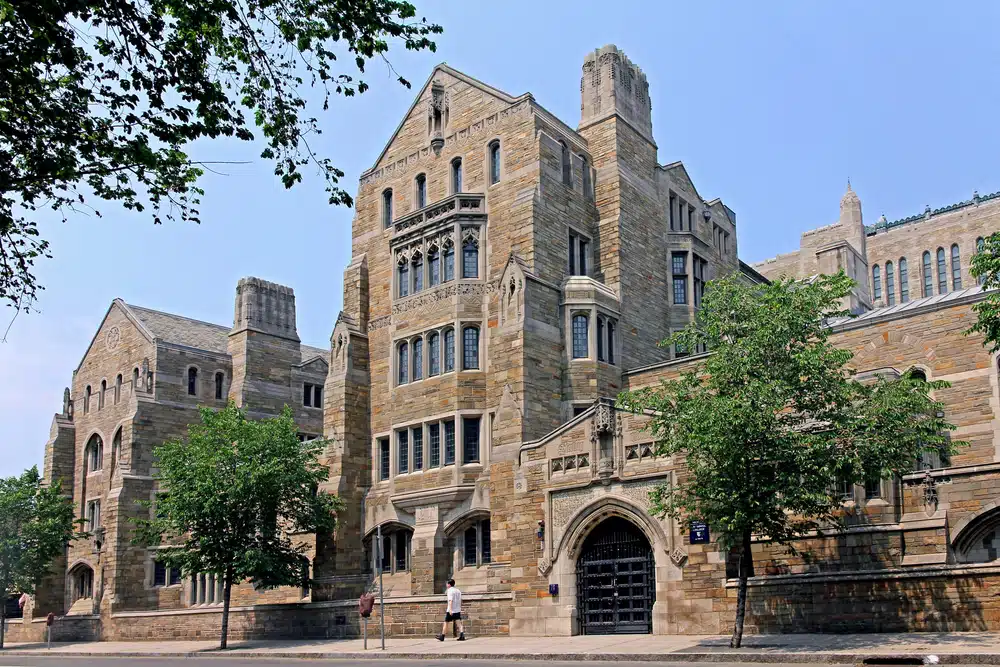Yale’s Yield Rate and Acceptance Rate: How They Change Every Year
In the competitive world of higher education, few metrics stand out so starkly in their ability to reveal a university’s prestige and desirability as the yield rate and the acceptance rate. These numbers provide a wealth of information about a university’s yearly admissions process, as well as its overall standing amongst other academic institutions. To illustrate this point, this article explores the annual fluctuations in Yale University‘s yield rate and acceptance rate, why they change year by year, and what these changes mean for prospective students.
Defining Yield Rate and Acceptance Rate
The concepts of yield rate and acceptance rate bear significant weight in higher education circles. These figures influence how a school structures its admissions strategy and portray a clear picture of its competitiveness and attractiveness in the eyes of prospective students. But exactly what do these terms mean?
The Meaning of Yield Rate
The yield rate, often referred to as the yield, measures the percentage of accepted students who choose to enroll in a particular university. This metric serves as a proxy for a school’s desirability. A higher yield rate indicates that a large proportion of admitted students value the educational opportunities at that university over offers from other institutions.
When considering the yield rate, it is important to understand the factors that contribute to a student’s decision to enroll. These factors can include the university’s academic reputation, the quality of its faculty, the availability of financial aid, the campus culture, and the location of the institution. Students may also consider the university’s extracurricular activities, internship opportunities, and the overall fit with their personal and career goals.
Universities with a high yield rate often have a strong reputation and are known for providing a high-quality education. They may offer unique programs or have a particular area of expertise that attracts students. Additionally, these universities may have a strong alumni network, which can provide valuable connections and opportunities for students after graduation.
The Significance of Acceptance Rate
On the other hand, the acceptance rate is the percentage of applicants who receive an offer of admission from the university. A low acceptance rate points to a university’s high selectivity, suggesting that the institution only accepts a small fraction of applicants, thereby indicating its competitive nature.
When a university has a low acceptance rate, it often means that the institution receives a large number of applications and has limited spots available for incoming students. This can create a sense of exclusivity and prestige, as students who are accepted into these universities are seen as highly accomplished and deserving of admission.
However, it is important to note that the acceptance rate alone does not determine the quality of education or the overall experience at a university. Many factors contribute to the strength of an institution, including the faculty, resources, and opportunities available to students. It is essential for prospective students to consider a variety of factors when making their college decisions rather than solely focusing on acceptance rates.
Furthermore, acceptance rates can vary widely among different types of universities. For example, highly selective Ivy League schools often have acceptance rates in the single digits, while larger public universities may have acceptance rates in the double digits. It is crucial for students to research and understand the specific context and characteristics of each university they are considering.
The Annual Fluctuations in Yale’s Yield Rate
Now that we’ve defined these concepts, let’s look at how they change annually, starting with Yale’s yield rate.
The yield rate, which refers to the percentage of admitted students who choose to enroll at Yale, is a crucial metric for the university. It provides valuable insights into the attractiveness of Yale’s programs, campus culture, and overall reputation. Understanding the factors that influence yield rate fluctuations is essential for the university’s admissions and enrollment strategies.
Factors Influencing Yield Rate Changes
The yield rate is subject to various factors, including changes in the school’s ranking, reputation, and financial aid policies. A higher ranking and positive reputation can significantly impact the yield rate, as they signal Yale’s academic excellence and desirability among prospective students. Additionally, the availability and generosity of financial aid packages play a vital role in attracting students who may have financial constraints.
Furthermore, shifts in socioeconomic conditions can affect the decisions of admitted students and, thus, the yield rate. For instance, during periods of economic recession, more students might choose universities offering more generous financial aid packages, impacting the yield rate. Conversely, during periods of economic prosperity, students may be more inclined to choose institutions based on other factors such as academic programs, campus facilities, and extracurricular opportunities.
Another factor that influences yield rate changes is the competition among universities. Yale competes with other prestigious institutions for top-performing students, and the decisions made by these students can significantly impact the yield rate. Universities often employ various strategies, such as personalized outreach, campus visit programs, and alumni engagement, to increase their yield rates and attract the most talented students.
The Impact of Yield Rate Fluctuations on Yale’s Reputation
The annual changes in the yield rate also impact Yale’s reputation. A consistently high yield indicates that Yale is a top choice for many students, thereby helping to maintain its standing as one of the most prestigious universities in the world. A strong yield rate demonstrates that Yale’s academic programs, faculty, and campus environment are highly regarded and sought after by prospective students.
Conversely, a decline in the yield rate may raise concerns about Yale’s competitiveness and desirability among students. It may prompt the university to reevaluate its recruitment strategies, financial aid offerings, and overall student experience to address any potential areas of improvement. Maintaining a high yield rate is not only a matter of prestige but also crucial for ensuring a diverse and talented student body that enriches the academic and social fabric of the university.
The Yearly Variations in Yale’s Acceptance Rate
Alongside the yield rate, the annual fluctuations in Yale’s acceptance rate also bear significant analysis.
Understanding the yearly variations in Yale’s acceptance rate provides valuable insights into the university’s admissions process and the factors that influence it. These fluctuations can be attributed to various factors, including the number of applicants, changes in admission policies, and the university’s capacity to accommodate students.
The Role of Application Numbers in Acceptance Rate
The acceptance rate is heavily influenced by the number of applicants each year. A rise in applications can result in a lower acceptance rate if the university’s capacity does not increase correspondingly, making the university appear more selective.
When Yale receives a surge in applications, it faces the challenge of selecting a limited number of students from a highly competitive pool. This increased competition among applicants leads to a decrease in the acceptance rate as the university strives to maintain its high academic standards and select the most qualified individuals.
Conversely, a decrease in the number of applications can lead to a higher acceptance rate. This may occur due to various reasons, such as changes in the university’s reputation, shifts in educational trends, or external factors that influence students’ decision to apply to Yale.
How Yale’s Acceptance Rate Affects Prospective Students
Fluctuations in Yale’s acceptance rate have a direct impact on prospective students. A lower acceptance rate can, on the one hand, intimidate some applicants, but it can also make an offer from Yale all the more desirable to those who value the exclusivity it implies.
For many students, receiving an acceptance letter from Yale is a dream come true. The university’s reputation for academic excellence, vibrant campus life, and extensive resources make it a highly sought-after institution. Therefore, a lower acceptance rate can create a sense of prestige and desirability around being admitted to Yale.
On the other hand, a lower acceptance rate can also generate anxiety and stress among prospective students. The competitive nature of the admissions process may lead some individuals to question their chances of being accepted, causing them to feel discouraged or overwhelmed.
Despite the challenges posed by a lower acceptance rate, it is important to remember that Yale’s admissions process aims to create a diverse and well-rounded student body. The university considers various factors beyond academic achievements, such as extracurricular involvement, personal experiences, and unique perspectives. This holistic approach ensures that Yale admits students who will contribute to the vibrant intellectual community and thrive in their academic pursuits.
Overall, the yearly variations in Yale’s acceptance rate provide valuable insights into the university’s admissions process and the factors that influence it. The number of applicants and the university’s capacity to accommodate students play a significant role in determining the acceptance rate. Fluctuations in the acceptance rate can impact prospective students, evoking both a sense of prestige and desirability, as well as anxiety and stress. Ultimately, Yale’s admissions process seeks to create a diverse and exceptional student body that will contribute to the university’s academic and social community.
Comparing Yale’s Yield and Acceptance Rates
Understanding Yale’s yield and acceptance rates independently offers value, but analyzing how these rates interact can offer additional insights.
The Interplay Between Yield and Acceptance Rates
Yale’s yield and acceptance rates jointly illustrate its standing amongst prospective students and its selectivity. A high yield rate combined with a low acceptance rate generally indicates a commanding prestige and desirability, a position Yale often finds itself in year by year.
When examining the interplay between yield and acceptance rates, it is important to consider the factors that contribute to Yale’s high yield rate. One such factor is the university’s strong reputation for academic excellence. Yale’s rigorous curriculum, distinguished faculty, and vibrant intellectual community attract top-tier students who are eager to be part of an institution that fosters intellectual growth and innovation.
Additionally, Yale’s extensive resources and opportunities play a significant role in its ability to maintain a high yield rate. The university offers a wide range of extracurricular activities, research opportunities, and internships that enhance students’ overall educational experience. This comprehensive approach to education not only attracts students during the admissions process but also ensures their continued engagement and satisfaction throughout their time at Yale.
Furthermore, Yale’s commitment to financial aid and its generous scholarship programs contribute to its high yield rate. The university strives to make education accessible to all qualified students, regardless of their financial background. By providing substantial financial support, Yale ensures that accepted students can confidently enroll without the burden of excessive student loans, making it an attractive choice for many prospective students.
How Yield and Acceptance Rates Reflect Yale’s Selectivity
While a high yield rate speaks to Yale’s allure, a low acceptance rate underlines its selectivity. Together, these rates exhibit the rigorous admission standards that Yale upholds and the high regard in which it is held by students and academics alike.
Yale’s low acceptance rate reflects the university’s commitment to maintaining a highly competitive and diverse student body. The admissions committee carefully evaluates each application, considering not only academic achievements but also personal qualities, extracurricular involvement, and potential for contributing to the Yale community. This thorough evaluation process ensures that only the most exceptional candidates are granted admission.
Moreover, Yale’s low acceptance rate is a testament to the university’s dedication to fostering an intellectually stimulating environment. By admitting a select group of students, Yale ensures that its classrooms are filled with individuals who are not only academically gifted but also intellectually curious and driven. This selective approach to admissions creates a vibrant and dynamic academic community where students can engage in meaningful discussions and collaborative research projects.
It is worth noting that Yale’s low acceptance rate does not diminish the accomplishments of those who are not admitted. The university receives a significant number of applications from highly qualified individuals, and the admissions process is highly competitive. Many exceptional candidates who are not accepted to Yale go on to thrive at other prestigious institutions, contributing to the overall academic landscape.
Overall, the interplay between Yale’s yield and acceptance rates provides valuable insights into the university’s standing and selectivity. The high yield rate signifies Yale’s desirability and prestige, while the low acceptance rate reflects its commitment to maintaining a competitive and intellectually vibrant community. By carefully considering these rates, prospective students and academics can gain a deeper understanding of Yale’s unique position in the academic world.
Predicting Future Trends in Yale’s Yield and Acceptance Rates
Given the annual fluctuations in Yale’s yield and acceptance rates, one question remains: What might the future hold for these rates?
The Influence of External Factors on Future Rates
External factors such as societal shifts, changes in population demographics, or global events can significantly influence future rates. Education policies and advancements in digital technology can also reshape the higher education landscape, affecting both the yield and acceptance rates.
The Potential Impact of Yale’s Policies on Future Rates
Yale’s own policies, such as those related to admissions, scholarships, or campus life, can also play a pivotal role in shaping future yield and acceptance rates. By understanding and adapting to these factors, Yale continues to maintain its position as a highly sought-after educational institution.
In summary, Yale’s yield rate and acceptance rate are constantly shifting figures that mirror a variety of influences. From changes in external conditions to internal policy adaptations, there are many factors that contribute to the annual changes seen in these rates. Understanding these metrics is crucial for prospective students and serves as an insightful tool for higher education stakeholders.
How AdmissionSight Can Help You With College Admissions
AdmissionSight is a college consulting firm that provides personalized assistance to students throughout the college admissions process. Here are some ways that AdmissionSight can help you:
Admissions strategy: AdmissionSight can help you develop a strategic plan for your college application process. Our professional consultants can assist with identifying schools that are a good fit for your academic, extracurricular, and personal goals and help you plan and prioritize your application strategy.
Application review: AdmissionSight can review your application and provide feedback on how to improve it. We can offer suggestions on making your application stand out and highlighting your strengths and unique qualities.
Essay coaching: AdmissionSight can help you craft compelling essays that showcase your personality, goals, and achievements. We can guide you through the essay writing process and provide feedback on your drafts to help you refine your writing.
Interview preparation: AdmissionSight can provide interview coaching to help you feel confident and prepared for college interviews. Our experts can offer tips on how to present yourself professionally and how to answer common interview questions.
Extracurricular planning: AdmissionSight can help you plan and develop your extracurricular activities to make them more impactful and meaningful. We can suggest activities that align with your interests and goals and provide guidance on demonstrating your leadership and initiative.
Overall, AdmissionSight can provide valuable guidance and support throughout the college admissions process to help you maximize your chances of getting accepted into the college of your choice.
With a high success rate of over 75%, we have built a strong network in the past decade. Book an initial consultation today, free of charge!









































